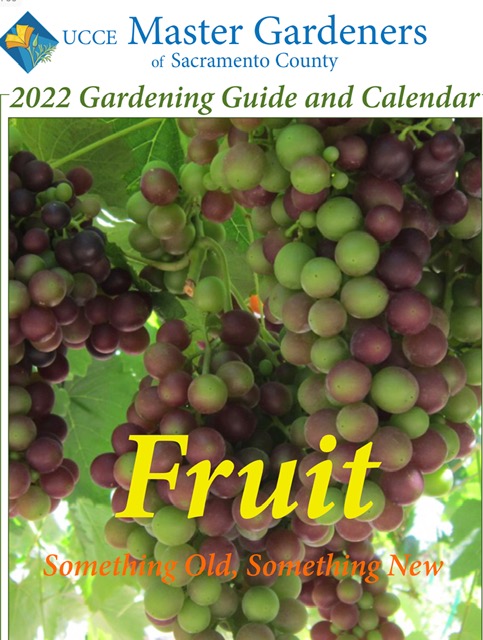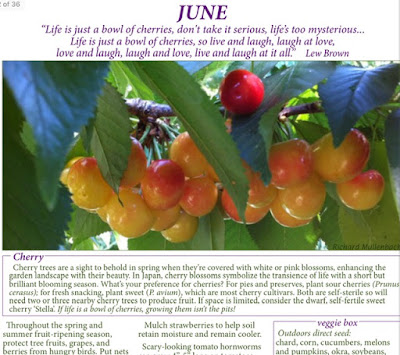
Harvest Day also marks the release of 2022 Gardening Guide and Calendar

|
|
Gorgeous grapes grace the cover of the 2022 Gardening Guide
and Calendar, which goes on sale Saturday. |
When the UCCE Sacramento County master gardeners decided last winter that the 2021 Harvest Day would be virtual, just as it was in 2020, it seemed like an overabundance of caution. But with the recent revival of mask mandates and other coronavirus protocols, Harvest Day fortunately can be celebrated safely this Saturday, from the comfort of our homes or gardens.
Get a jump on events by watching master gardener Teri VanAirsdale in the 5-minute 2021 Welcome video ; she covers the full schedule.
The three keynote speakers' presentations also are online already, on the Sac County master gardeners' YouTube channel. Plus, speakers Fred Hoffman, Greg Gayton and Bill Krycia will answer gardeners' questions during a live session online Saturday from 8:30 a.m. to 10:20 a.m.
Then three webinars are scheduled, from 10:30 a.m. to 1 p.m., featuring these master gardeners:
* Quentyn Young explores growing new and unusual edibles.
* Lori Ann Asmus provides inspiration for greening the indoor environment with houseplants.
* Ruth Ostroff shares her know-how and enthusiasm for the hardy, drought-tolerant bearded iris.
To receive the link to participate in these online events, register for free here: sacmg.ucanr.edu
All of these online events will be recorded for viewing later, as well.
Saturday also marks the release of the 2022 Sacramento Gardening Guide and Calendar, a popular fundraiser each year for the master gardeners. It's still bargain-priced at $10, including sales tax. It can be ordered online here starting Saturday . (Postage is extra if you order it mailed.) Local retailers typically carry it, too, in the fall. And in-person master gardener events, including the Sept. 11 Open Garden, will have it for sale.

|
|
Each month includes information on the featured fruit, plus
garden tips for the month, and a suggested less-common fruit
to grow.
|
Master gardeners Pat Turner and Angela Parker filmed a short preview of the Gardening Guide; view it here . (Full disclosure: In my other identity as a master gardener, I helped with the preparation of this year's Gardening Guide. Fun!)
Comments
0 comments have been posted.Sacramento Digs Gardening to your inbox.
Food in My Back Yard Series
May 6: Maintain soil moisture with mulch for garden success
April 29: What's (already) wrong with my tomato plants?
April 22: Should you stock up on fertilizer? (Yes!)
April 15: Grow culinary herbs in containers
April 8: When to plant summer vegetables
April 1: Don't be fooled by these garden myths
March 25: Fertilizer tips: How to 'feed' your vegetables for healthy growth
March 18: Time to give vegetable seedlings some more space
March 11: Ways to win the fight against weeds
March 4: Potatoes from the garden
Feb. 25: Plant a fruit tree now -- for later
Feb. 18: How to squeeze more food into less space
Feb. 11: When to plant? Consider staggering your transplants
Feb. 4: Starting in seed starting
Sites We Like
Garden Checklist for week of May 11
Make the most of the lower temperatures early in the week. We’ll be back in the 80s by Thursday.
* Plant, plant, plant! It’s prime planting season in the Sacramento area. Time to set out those tomato transplants along with peppers and eggplants. Pinch off any flowers on new transplants to make them concentrate on establishing roots instead of setting premature fruit.
* Direct-seed melons, cucumbers, summer squash, corn, radishes, pumpkins and annual herbs such as basil.
* Harvest cabbage, lettuce, peas and green onions.
* In the flower garden, direct-seed sunflowers, cosmos, salvia, zinnias, marigolds, celosia and asters. (You also can transplant seedlings for many of the same flowers.)
* Plant dahlia tubers.
* Transplant petunias, marigolds and perennial flowers such as astilbe, columbine, coneflowers, coreopsis, dahlias, rudbeckia and verbena.
* Keep an eye out for slugs, snails, earwigs and aphids that want to dine on tender new growth.
* Feed summer bloomers with a balanced fertilizer.
* For continued bloom, cut off spent flowers on roses as well as other flowering plants.
* Add mulch to the garden to maintain moisture. Mulch also cuts down on weeds. But don’t let it mound around the stems or trunks of trees or shrubs. Leave about a 6-inch-to-1-foot circle to avoid crown rot or other problems.
* Remember to weed! Pull those nasties before they set seed.
* Water early in the day and keep seedlings evenly moist.